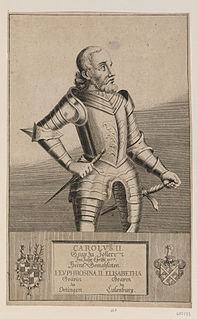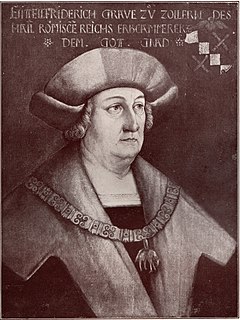Related Research Articles

The House of Hohenzollern is a German royal dynasty whose members were variously princes, electors, kings and emperors of Hohenzollern, Brandenburg, Prussia, the German Empire (respectively), and Romania. The family came from the area around the town of Hechingen in Swabia during the late 11th century and took their name from Hohenzollern Castle. The first ancestors of the Hohenzollerns were mentioned in 1061.

Hohenzollern-Sigmaringen was a principality in Southwestern Germany. Its rulers belonged to the senior Swabian branch of the House of Hohenzollern. The Swabian Hohenzollerns were elevated to princes in 1623. The small sovereign state with the capital city of Sigmaringen was annexed to the Kingdom of Prussia in 1850 following the abdication of its sovereign in the wake of the revolutions of 1848, then became part of the newly created Province of Hohenzollern.

Albert III was Elector of Brandenburg from 1471 until his death, the third from the House of Hohenzollern. A member of the Order of the Swan, he received the cognomen Achilles because of his knightly qualities and virtues. He also ruled in the Franconian principalities of Ansbach from 1440 and Kulmbach from 1464.

The Order of the Black Eagle was the highest order of chivalry in the Kingdom of Prussia. The order was founded on 17 January 1701 by Elector Friedrich III of Brandenburg. In his Dutch exile after World War I, deposed Emperor Wilhelm II continued to award the order to his family. He made his second wife, Princess Hermine Reuss of Greiz, a Lady in the Order of the Black Eagle.

Conrad I of Nuremberg was a Burgrave of Nuremberg of the House of Hohenzollern. He was the elder son of Frederick I of Nuremberg and Sophie of Raabs.
Friedrich I of Nuremberg, the first Burgrave of Nuremberg from the House of Hohenzollern. He was the younger son of Count Friedrich II of Zollern, and became Count of Zollern as Friedrich III after the death of his other male relatives.

The Burgraviate of Nuremberg was a state of the Holy Roman Empire from the early 12th to the late 15th centuries. As a burgraviate, it was a county seated in the town of Nuremberg; almost two centuries passed before the burgraviate lost power over the city, which became independent from 1219. Eventually, the burgraviate was partitioned to form Brandenburg-Ansbach and Brandenburg-Bayreuth.

The House Order of Hohenzollern was a dynastic order of knighthood of the House of Hohenzollern awarded to military commissioned officers and civilians of comparable status. Associated with the various versions of the order were crosses and medals which could be awarded to lower-ranking soldiers and civilians.

Sigmaringen Castle was the princely castle and seat of government for the Princes of Hohenzollern-Sigmaringen. Situated in the Swabian Alb region of Baden-Württemberg, Germany, this castle dominates the skyline of the town of Sigmaringen. The castle was rebuilt following a fire in 1893, and only the towers of the earlier medieval fortress remain. Schloss Sigmaringen was a family estate of the Swabian Hohenzollern family, a cadet branch of the Hohenzollern family, from which the German Emperors and kings of Prussia came. During the closing months of World War II, Schloss Sigmaringen was briefly the seat of the Vichy French Government after France was liberated by the Allies. The castle and museums may be visited throughout the year, but only on guided tours. It is still owned by the Hohenzollern-Sigmaringen family, although they no longer reside there.

Charles II, Count of Hohenzollern-Sigmaringen(German: Karl II, Graf von Hohenzollern-Sigmaringen) became Count of Hohenzollern-Sigmaringen in 1576 and remained so until his death. He was the fifth but second surviving son of Charles I, Count of Hohenzollern, and Anna, daughter of Ernest, Margrave of Baden-Durlach.

Burkhard I, Lord of the House of Hohenzollern is considered the first well-documented ancestor of the Hohenzollern dynasty. Because of his name, it has been attempted to link the Hohenzollern family's descent to the medieval Burchardings family, but without success. His father may have been Friedrich, a count in the Sülichgau area. His mother may have been Irmentrud, the daughter of Count Burkhard of Nellenburg.

Frederick I, Count of Zollern, was often cited as a powerful Swabian Count and supporter of the imperial party of Henry V, Holy Roman Emperor.
Count Friedrich IV of Zollern, also known as Burgrave Friedrich II of Nuremberg, was Burgrave of Nuremberg from 1204 to 1218 and Count of Zollern from 1218 until his death.
Friedrich V of Zollern nicknamed, the Illustrious was a Count of Zollern.

The Counts of Lenzburg were a comital family in the Duchy of Swabia in the 11th and 12th centuries, controlling substantial portions of the pagi of Aargau and Zürichgau.

Eitel Friedrich II, Count of Hohenzollern was a count of Hohenzollern and belonged to the Swabian line of the House of Hohenzollern. He was the first president of the Reichskammergericht. As a close friend of the Archduke and later Emperor Maximilian I, he gained great influence in the imperial politics. He managed to consolidate and expand his own territory.
Friedrich IX, Count of Hohenzollern, nicknamed "Fredrick the Old" or "the Black Count", was a German nobleman. He was the ruling count of Hohenzollern from 1339 until his death.

The Counts of Dillingen were a Swabian comital family of the Hupaldinger (Hucpaldinger) dynasty during AD 955–1286.
The German Emperors after 1873 had a variety of titles and coats of arms, which in various compositions became the officially used titles and coats of arms. The title and coat of arms were last fixed in 1873, but the titles did not necessarily mean that the area was really dominated, and sometimes even several princes bore the same title.
References
- ↑ "Friedrich II. Graf von Zollern" . Retrieved January 30, 2013.
- ↑ Schultze, Johannes; Seigel, Rudolf (1972). "Hohenzollern, Dynastengeschlecht". Neue deutsche Biographie, Bd.: 9, Hess – Hüttig, Berlin. Bayerische Staatsbibliothek. Retrieved January 30, 2013.
- 1 2 3 "Friedrich I. Graf von Zollern" . Retrieved January 30, 2013.
- ↑ Hohenzollern Ancestry,